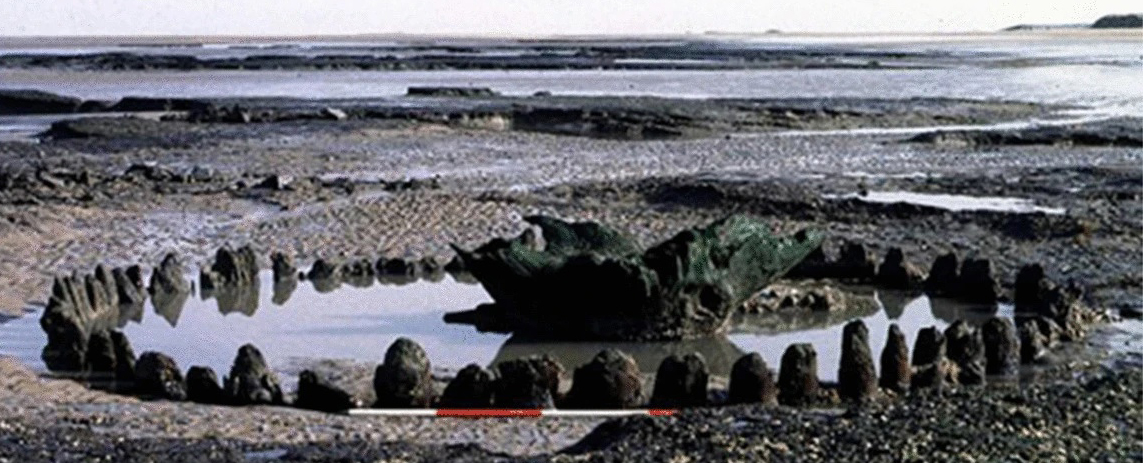When tidal erosion exposed a mysterious Bronze Age structure on a beach in Norfolk, England, it captured the imaginations of archaeologists and pagans alike, who recognized the site may hold spiritual significance.
New research supports this hunch, suggesting the monument and a similar structure nearby were created for climate rituals at a time when severe winters plagued the region.
Known colloquially as ‘Seahenge’ and officially as Holme I, the prehistoric monument consists of an upturned oak stump encircled by 55 split trunks of the same wood.
When it was constructed in the late spring of 2049 BCE, Seahenge was at no risk of tidal erosion. It was built on a salt marsh away from the shore, protected by sand dunes and mud flats. In the swampy marsh, the timbers were cradled by peat that once protected them from decay.
And for several thousand years, silt and sand built up, eventually concealing the mystic circle.
The more recent exposure of Seahenge is, in some ways, a climate story of its own – one of the many archaeological gauges exposed by the tides, showing sea levels encroaching higher on land than they have in millennia.
Beachcomber and amateur archaeologist John Lorimer is credited with discovering the site, first spotting a Bronze Age ax head in the sand, and over the course of many return visits, watching as the inverted tree stump and eventually the wooden ring were revealed.
In 1999, archeologists began excavating the monument, with the goal of preserving and relocating it. The media dubbed it ‘Seahenge’ despite it not being a true henge, attracting widespread attention that led to pagan and New Age groups along with locals protesting the excavation, staking claims on the site, and demanding it be kept in situ.
But the archeologists continued their efforts, and now Seahenge is on display at Lynn Museum, preserved with wax where the seawater once was.
Holme II, discovered around the same time about 100 meters (328 feet) away, has been left in place (perhaps to avoid a repeat of the Seahenge drama) and exposure to the sea’s tides has already washed much of it away.
Now, archaeologist David Nance from the University of Aberdeen has put forward a theory that the site and its doomed neighbor were constructed to ward off the hardships of a changing climate in a bygone era.
“We know that the period in which they were constructed 4,000 years ago was a prolonged period of decreased atmospheric temperatures and severe winters and late springs placing these early coastal societies under stress,” says Nance.
“It seems most likely that these monuments had the common intention to end this existential threat but they had different functions.”
Nance’s theory goes against earlier suggestions that they are memorial sites, and draws on climatic and environmental data, astronomic and biological evidence, and regional folklore.
He notes the timbers were felled in spring, and arranged to align with the sunrise on the summer solstice.
“Summer solstice was the date when according to folklore the cuckoo, symbolizing fertility, traditionally stopped singing, returned to the Otherworld and the summer went with it,” Nance says.
He believes the monuments were designed to ‘capture’ the cuckoo and thus extend the summer – an appealing notion in a climate where these early coastal societies struggled through bitter and long winters.
“The monument’s form appears to imitate two supposed winter dwellings of the cuckoo remembered in folklore: a hollow tree or ‘the bowers of the Otherworld’ represented by the upturned oak-stump at its center,” says Nance.
“This ritual is remembered in the ‘myth of the pent cuckoo’ where an unfledged cuckoo was placed into a thorn bush and the bird was ‘walled-in’ to extend the summer but it always flew away.”
He suggests Holme II, which is suspected to have contained a human body, was constructed to “house the ritually sacrificed body of a mortal consort of the Venus deity,” someone charged with the responsibility of ensuring the community’s wellbeing and fertility, but who was seen to have failed.
“Evidence suggests that they were ritually-sacrificed every eight years at Samhain (now Halloween) coincident with the eight-year cycle of Venus,” Nance explains.
“The fixtures in Holme II that were thought to hold a coffin are orientated towards sunrise on Samhain in 2049 [BCE] when Venus was still visible.”
While both monuments had different functions and associated rituals, he says, their common intent was to end the severely cold weather.
Perhaps it worked a little too well.
This research is published in GeoJournal.





